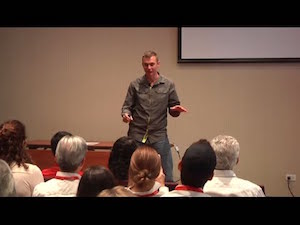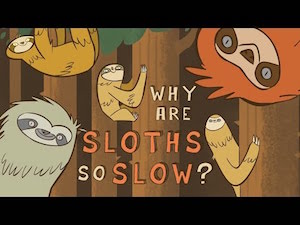The Surprisingly Fast World of Sloth Sleuthing | Bryson Voirin | Tedx Talks
Bryson Voirin talks about the surprisingly fast paced world of studying sloths in the rain forest. Scientists have a lot to learn from sloths. But Bryson has found often times it’s more important to share scientific findings with the general public, and not simply scientists.
Bryson Voirin is a wildlife neuroscientist at the Max Planck Society in Germany, a conservation drone researcher at the California Academy of Sciences, and a freelance TV presenter. His passion for science and the natural world began at a young age. Growing up in Florida, he spent his early years “exploring” the forests, fields, and backyards around his house. Upon moving to Germany during high school, Bryson’s exposure to new and foreign ecosystems strengthened his interest in the outdoor, leading him to pursue environmental and biological research in numerous countries during university. Both an Udall and Fulbright Scholar, Bryson’s scientific research and conservation work has been published in peer-reviewed journals, featured in international newspapers and magazines, and covered on television programs from around the world.
This talk was given at a TEDx event using the TED conference format but independently organized by a local community.
Video Transcript
So there’s a game that I love to play when I’m sitting next to someone I don’t know on an airplane. Bet you can’t guess what I do, like Dr – No, Lawyer – No, Engineer – No. If I drop a couple hints, I climb trees, like you’re a tree trimmer? like I’m a sloth scientist. Get out of here, no way I don’t believe it. Then I’m like not only am I a sloth scientist, I specialise in studying the sleep patterns of wild sloths. At this point their convinced I’m a lying liar, and they’re like theres no way you do that. I pull my phone, I show them pictures, you know I really am the sloth sleuth. And then they’re like, thats a job? How in the heck did you get into studying sloths. Thats the weirdest thing I have ever heard of, and I’m like thats actually a kinda funny story. I got into studying sloths kind of as a joke.
I was in Panama working for a TV programme and a scientist and I were joking about it saying why is it that these sloths poop on the ground. Which is a real story, they actually live their whole life in the canopy except once a week sloths climb all the way down out of the tree, they dig a little hole, they go to the bathroom, they bury it, they crawl back up the tree and live their life. And what’s weird about this is that they are a canopy animal, they live up there their whole life and they actually get killed going to the bathroom all the time. What the heck, why wouldn’t they just poop in the trees like a monkey? It’s such a paradox in tropical scientists all joke about this so and were all laughing and having some drinks about it and it kinda got me thinking you know I climb trees, wouldn’t it be fun to try and answer that. So I started working with sloths 13 years ago, and I had a great time since then, I’ve learnt some pretty cool stuff.
The funny thing is catching sloths is one thing people ask me, oh you must’ve chose sloths because they are so slow and so easy to catch. Not exactly. Sloths live up in the trees, so to get up there I have to use a harness, and some ascenders and a rope and climb up there, and a sloth can move, they don’t just sit there. They move, about that fast, which is pretty slow. But if I have to climb up 100 feet into a tree, by the time I set my ropes up and I get up there and finally catch a sloth, it might be 2 or 3 trees away. so then I have to come down, I got to reset my lines and try again, and the sloth will look at me and kinda crawl away slowly, and they always go to the top of the tallest tree on the end of the smallest branch that I can’t get to. So it’s usually me getting out foxed or out run by a sloth, so I am actually slower than a sloth sometimes, and they are the worlds slowest mammals, so it doesn’t say much about my speed. But they can move fast actually, they can actually bite you.
I am one of the few people who has the privilege of having being bitten by a sloth. I had to go to the hospital and they had to sew my finger up and clean it out. The surgeons looking at me, she’s like, were you asleep, you were bitten by this animal? I have never heard of this. Im like, okay, the patients are laughing, like hahaha, and I am crying because it hurts so bad I’m worried that I’m going to lose my finger or something. The doctor looks at me, she’s like, I want to remind you not to stick your finger down any more throats of sloths, because that’s really stupid. Im like ok ok, and everybody’s laughing and she wrapped my hand up in a bright bandage. And everyone in the hospital knew so everyone in the whole city knew, and they’re all like, you’re that guy who was bitten by the sloth? And still people today asked me when I’m out in Gamboa, they’re like, you’re that guy that was bitt by a sloth aren’t you, did you get special powers like spider man when he was bit by the spider he could do amazing things. Do you get really sleepy sometimes, and like really lazy. There are a lot of jokes about this.
But one of the really cool things that I get to study about sloths is looking at their sleep patterns. And its partly just because its funny to talk about sleeping sloths, it’s hilarious, but they’re actually a really neat animal. And a lot of people ask me then, why do you study sleeping sloths, like who cares, well everyone sleeps, probably everyone of us slept last night and every animal ever studied has been shown to sleep. A fruit fly, a blue whale, a human, everything sleeps in some capacity. And actually we don’t really know why we sleep. All we know is that if we don’t sleep, you’ll die. It’s really important you do that. And sleep scientists can’t really agree on what sleep does for us, the only thing they can agree upon is that you sleep because your tired. That’s it. We don’t really know what it does for our bodies. and we know that it’s really important, so instead of just studying sleep in humans or sleeping in rats, like a lot of scientist, I like to study sleep in fun animals, like koalas and sloths and frigate birds, because it’s really fun but it’s important to look at the diversity of sleep throughout the animal kingdom, because the way that a fruit fly sleeps is different than the way a human sleeps, or different than the way a sloth sleeps. So if I can look at all these different animals and see how they’re sleeping, I can look at the differences and the similarities of sleep throughout the animal kingdom and perhaps better understand why we sleep. Which is kind of fun and I get to catch sloths which is really great.
And you know one thing to mention about sleep is that, it’s not just your brain shutting off and so when you ask a person well, whats happening when your sleeping, sometimes your dreaming, sometimes your doing things. Your brain is not just going offline, it’s actually firing in a different pattern, in a different way. And so studying sleep in sloths, I have these tiny little computer devices that go on their head that records their brain waves. So you can study sleep in some animals by just looking at them and just saying oh well she’s asleep, or he’s asleep, or that thing is not asleep, it’s awake. But its really difficult to tell the sloth, because they’re sedentary, they sort of just sit there. So I have to use these devices to record an EEG, an electroencephalogram and through that then I can look at the brain wav patterns and I can determine when its sleeping, hows its sleeping, if its in REM sleep, thats when your eyes are moving back and forth, your dreaming, if its in non REM sleep, and I can look at those cool stuff with it, and one thing that I focus on though is only working with wild animals. Partly because I like to run around the rainforest because its really fun. But because studying animals in captivity, its not the same as studying a natural animal.
If I studied sleeping humans, how many of you have slept overnight on a flight somewhere. Gone to Europe or something? It’s really not easy to sleep on a flight, you maybe get a couple of hours and its not that great. If I was to only to ever study sleeping humans on airplanes flying to Europe, I’d have a pretty weird perception of how we sleep. So if I only look at animals in the zoo, it’s the same kind of thing because physiologically its like a different species if you compare to captive, versus the wild individuals there. And the same is true for sloths, the first ever wild sleep study was with books and we found that a sloth in captivity sleeps 15 to 16 hours a day. That’s pretty slothful, that’s pretty lazy, that’s a lot, that’s more then I sleep. But if we look at sloths in the wild, they only sleep 9 to 10 hours a day which is a heck of a lot less. So you think why would it be such a difference between captivity versus the wild.
Well in a zoo, sometimes you see the lion, kind of restlessly going around looking depressed, there’s a lot of differences you see in captivity versus the wild. They don’t have any friends, they not going to get eaten by something. So it’s really almost like a different species altogether when you look at the wild animals. Theres another cool study that I did with sloths looking at predation pressure. So if sleep evolved in every sort of thing, from flies to whales to humans and these things, but theres a lot of differences. There are prey animals and predators, there are a lot of difference when they sleep. So prey animals tend to sleep at opposite times as to predators, so a sloth for instance gets eaten a lot at night time by ocelots, so for a sloth to be up in a tree safely sleeping it’s a good idea they sleep at the opposite time as their predator.
So I looked at two populations of sloths in Panama. One, on the mainland with high predation where they get eaten all the time by ocelots, another on this island off the coast of Panama, where they live this totally relaxed Caribbean lifestyle, they sit in mangrove trees and just enjoy the sunshine, and I found there was this huge difference in the way they sleep. Actually the ones on the mainland have exactly what I predicated, they sleep at opposite times to their predators, at night time they’re totally asleep, whilst the guys on the islands, they don’t have any predators to fear, so they have sleep patterns whenever they want to. They could be awake and asleep and playing around in the ocean, and stuff, they actually swim too, and so its very interesting to see how maybe the sleep patterns have adapted around predation pressures.
Now as a scientist I am responsible for sharing this information with the public. And so we as scientists we write journal articles, these peer reviewed journal articles. I have to pay to publish these things, and they’re reviewed by the scientists and they go out to the scientific community. But there’s something funny though a lot of people not in academia aren’t aware of, those are not accessible to everyone. If you guys wanted to read my last journal article that I wrote about pigmy sloths, you got to pay for it. I have to pay for it, I don’t even get access to the journal, so its kinda funny I write any article that I can’t even read. So I got into science through television many years ago being down here so I’ve always tried to share my information with as many people as possible. I’ve hosted tons of tv shows, written blogs, articles for difference newspapers and magazines, trying to get people excited about sloths because sloths are so much fun.
And I find that people want to learn about this stuff and so I figure that it’s really important that we as scientists share our information with people. And a lot of the older scientists don’t really see the point of that they want to just want to publish these journal articles so other scientists can read them and sit there and say they are this great thing. But I think it’s amazing that if I write an article, maybe 100 people read it, but if I do a TV show, I do a kids show that 10 million people watch, it’s such a powerful tool to be able to share information about science or conservation or sloths or anything you want to, and so I think it’s really important that we as scientists share with the community.
That the population of sloth that I worked on with no predators on this island, they were actually pygmy sloths, they were really cool, they’re 40% smaller then the standard 3 toed sloth, they’re only found on this one island of the coast of Panama. There awesome, super cool animal, really relaxed, you can walk right up to them, touch their hair, they don’t care. Normal sloths, don’t do that, they’ll bite you, not good. And there really cool animals, but the people in Boca Sol Toro, and the area around there, weren’t really aware that it’s an endemic special species and that they are actually critically endangered, there is only a few 100 of them in the whole world, and they’re all on this one island.
When I first started going out there about ten years ago, every time I’d go there, you’d hear chainsaws cutting down mangroves and trees and people really destroying the island very quickly. We started doing a lot of public outreach conservation efforts, I did a lot of tv shows, with the BBC, with some Japanese crews, some American crews, trying to raise the profile of the pygmy sloth in Panama and around the world, and it worked. People now all over the world email me saying I saw your program about pygmy sloths, that’s so cool, that’s so great. They’re actually going to do one about flagship species of BCC’s new series coming up this fall, called Planet Earth Two, so watch for that it’ll be really neat.
And the people in the community they all now know about pygmy sloths, they’re all aware that there is this really cool miniature baby sloth that’s super cute, that there is only one and that it belongs there. So many people are aware of this actually that a few years ago when an American Zoo tried to export some of these sloths legally, they had permits that they got somehow, the local people said no. Even the police stepped up and they said, I don’t care if you have permits, these sloths are ours they belong here on this island and no where else. They actually went on their private airplane took the sloths off, and bought them back to the island. So the people really rose up, and that’s a relief, I think a powerful example of how people really do care about their environment, and if they’re aware of what’s going on out there, then they really do take ownership of that, and I think as scientists we need to do as much as we can to share our information with people so that we can help conserve the environment.
Now no sloth talk is complete without a sloth, they wouldn’t let me bring an actual sloth here but I’ve got something thats almost as good. We have a 3 toed sloth, this is about the size of the small pygmy sloth, so they’ve got 3 fingers, 3 toes, but did you guys know that all sloth have 3 toes. All sloths have 3 toes. In english we say toes, in Spanish you say dedos, exactly, in German they say finger, but in English I just think its easier to say toe than finger, so for some reason they say oh yes the two toed sloth and the three toed, but actually they all have the same number of toes, it’s the number of fingers that differs. So this one, three toed, but also three fingered and its little baby. This is one of my sleep study sloths, see the little Abraham Lincoln hat on the top, that’s a microcomputer that can record their brainwaves. All I do is I put it on with super cool, totally cool, works on people too. This is a pygmy sloth, see how adorable they are, little tiny thing, sitting in the trees, they’re just very very cool animals. They swim in the ocean too, very cool.
This is a two toed sloth, hmm grumpy the sloth, he’s not very happy as he has a regular collar on. Two toed sloths actually can move very quickly, they can be aggressive and sometimes in the tree, they’ll look at me and they’ll start going after me. Swiping and trying to take me out, whilst the three toed sloths don’t usually care. Sometimes the two toed sloth can get so angry and aggressive, they will be really scary. And that’s like the one that bit me on the finger and that earned me a couple of nicknames, one of them which is , but the one that I like better is , the five toed sloth, and that’s what my parents had to call me, I’m the five toed sloth.




